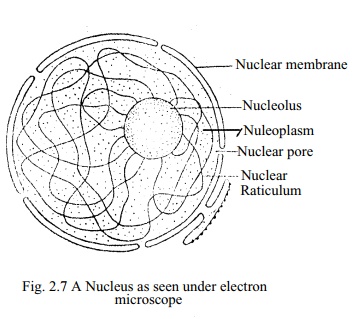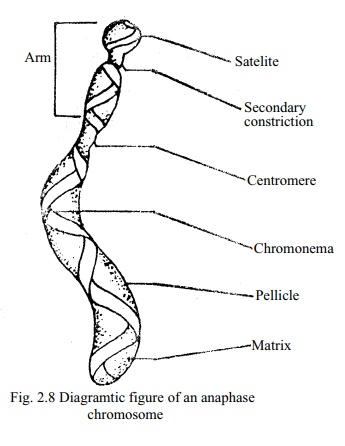Chapter: Biology: Structure and Nature of Living Cell
Nucleus: Stucture, Functions

Nucleus:
Denser and clearer organ found in the protoplasm is Nucleus. Robert Brown discovered and named nucleus in 1831 AD in the cell of orchid leaf. Normally each cell contains one nucleus. Some eukaryotic cell like sieve tube, mature red blood cells of mammal do not have nucleus. Usually nucleus is spherical and present at the centre of the cell. They may be present by the side of a large vacuole. Nucleus may smaller or larger in size and shape.
Function : Nucleus controls the total activity of the cell.

Structure: Chemically they are made of nucleic acid and protein. It containssome protein, trace of DNA (Deoxi-ribo nucleic acid) and RNA (Ribo Nucleic Acid), little amount of Co-enzyme and other materials. Physically they are made by the following parts: - Nuclear membrane, Nucleoplasm, Nucleolus and Chromosome

Nuclear membrane: The doublelayered transparent membrane, which make the outer covering of the nucleus is the nuclear membrane
The outer membrane porous but the inner one is not. Chemically the membrane is made of protein and lipid.
Function: The main function ofthis membrane.is to keep the nucleoplasm, chromosome and the nucleus distinct from cytoplasm. Transportation and communication between internal materials and cytoplasm is also done through this membrane.
Nucleoplasm: It is a transparentand dense fluid bounded by nuclear membrane. Nucleolus and chromosomes are present in it.
Function: It holds chromosomes andperforms various organic functions.
Nucleolus: The denser, small and round body found in the nucleus is thenucleolus. Every nucleus normally contains a single nucleolus. Nucleolus is usually attached to a certain area of a Particular chromosome. The region of chromosome where it remain attached is called `secondary constriction'.
Chemical composition: The main compositions of the nucleolus are protein,RNA and a trace of DNA.
Physical structure: Nucleolus is usually divided into three parts namelyfibrous, granular and matrix.
Function: To synthesise various types of DNA and protein and preserve them.Chromosome: In every nucleus there is a definite number of chromosomes according to the characteristic of definite species. It can be seen under microscope after proper staining, only in a dividing cell. Every chromosome contains one or more centromere, one chromonema or more chromonemata and some chromosome may have satellite. Chromosome bears a number of gene and genes are responsible for expressing characteristics of different species.
Chemical composition of chromosome: Chemically each chromosome iscomposed of DNA, RNA, Histon and non-histon protein. Besides, some calcium and magnesium are also present here.
Function: Chromosome is the bearer and carrier of hereditary properties of the organism.
Related Topics